Title: First Identification of Direct Collapse Black Hole Candidates in the Early Universe in CANDELS/GOODS-S
Authors: Fabio Pacucci, Andrea Ferrara, Andrea Grazian, Fabrizio Fiore, Emanuele Giallongo, Simonetta Puccetti
First Authors Institution: Scuola Normale Superiore, Italy
Paper Status: published in the Monthly Notices of the Royal Astronomical Society, March 2016
The Monsters
Black holes, the strange objects within which time and space break down, have never directly been observed: trying to see something from which light cannot escape is a bit foolhardy (though they do emit other types of radiation that we may have glimpsed). However, Astronomers can see the effects that these objects have on their surroundings, and infer their presence. For example, observations of the stars at the centre of our galaxy suggest they’re orbiting something huge, but we can’t see anything there – the only reasonable candidate is a Supermassive Black Hole.
The Problem…
Such giant black holes have been observed at the centres of almost all galaxies and some of them can get very hungry, gobbling up nearby gas and spewing it out in huge jets. These active black holes are known as Quasars, and they’re some of the brightest objects in the sky. We can observe them as far back as just 700 million years after the Big Bang (the universe is 13.7 billion years old, so this is really early in the universe’s history). Such large black holes so soon after the Big Bang are controversial though – they are, arguably, too big.
The controversy centres on how astronomers believe these giant black holes first formed. One theory suggests that seed black holes, formed not long after the big bang, would slowly grow, by accreting gas, in to the giants that we see as Quasars. Unfortunately though, there is not enough time for these tiny black holes to gain enough mass. Another theory suggests that the first stars, truly giant objects with masses hundreds of times larger than our Sun, would quickly explode as supernovae and collapse in to big black holes. But again, not big enough.
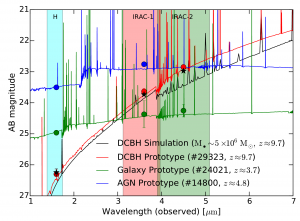
Figure 1: Observed spectrum of light from three objects in the catalogue, a Galaxy (green), Active Galactic Nuclei (AGN, in blue, otherwise known as a Quasar), and a Direct Collapse Black Hole candidate (red), alongside the theoretical spectrum predicted by simulations (black). The close agreement between the simulated spectrum in black, and the candidate in red, led the authors to believe that this could be a direct collapse black hole.
A Solution?
This led theorists to come up with a new explanation: Direct Collapse Black Holes. If the conditions in the early universe, before the first stars and galaxies, were just right, then large gas clouds could collapse, without fragmenting, directly down in to giant black holes. These would be big enough to grow in to the Quasars we observe later. A neat solution! (see the following Astrobite for more details on how the collapse happens). If the theory is true then we could potentially see the light from these monster black holes at the centre of the giant clouds. This is the subject of today’s paper. The authors carry out simulations of a giant black hole at the centre of a cloud of gas, and use this to predict the kind of radiation such an object would emit, and how it might look to us observing it from Earth today.
The gas that collapses to form the black hole is pristine, by which we mean it has almost no heavy elements (bigger than Hydrogen or Helium), known by Astronomers as metals. Metals can only be formed in stars, and since the direct collapse black hole forms before the first stars there aren’t any metals available. The radiation emitted by the black hole as it eats the nearby gas will travel through this pristine gas, and leave signatures in the light. It is these signatures, modelled using the simulations, that the authors then go looking for in real observations (see Figure 1 for an example from the paper).
Monster Hunting
They begin by looking at objects in the GOODS-S field, a patch of the sky surveyed by lots of different observatories in a number of different wavelengths. They narrow down their search by only including objects which have the same light signature as the one that they modelled. They also exclude objects that aren’t from the early universe (below a redshift of six). Finally, they exclude objects without a strong X-ray signal; supermassive black holes in the nearby universe emit X-rays, so it’s reasonable to assume that these early black holes would do the same. After this filtering, they end up with two candidates, shown in Figure 2. In the authors own words, “These objects represent the most stringent observational identification of black hole seed candidates, likely formed as Direct Collapse Black Holes, so far obtained.”
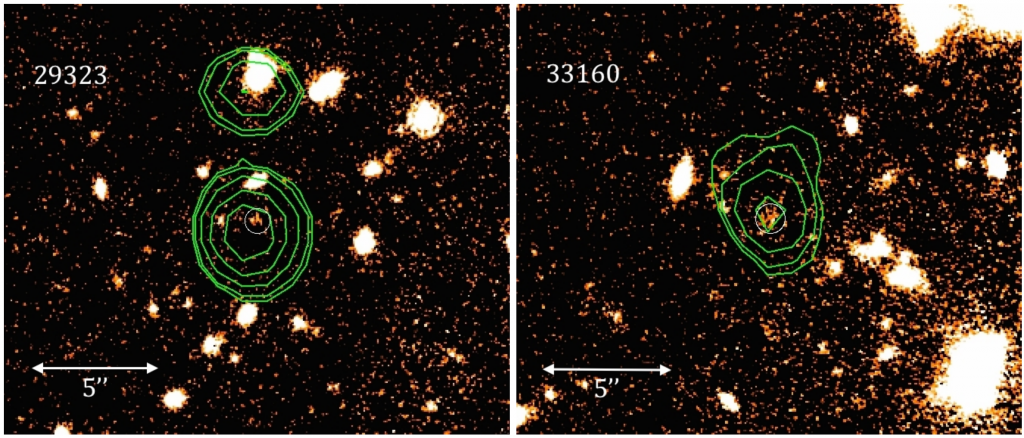
Figure 2: The two direct collapse black hole candidates identified in the GOOD-S field. The background image is in the near infrared, the green contours show the X-ray emission. 29323 has a redshift of 6.06, whilst 33160 is at a a whopping 9.73, just 500 million years after the big bang.
Exciting stuff! But there are a few caveats, which the authors are frank about. For a start, they don’t actually model the initial collapse of the black hole, and how this actually plays out is still uncertain. They also assume that the gas cloud is spherical, that the black hole eats gas very efficiently, that there is absolutely no nearby star formation, and that the ages they estimate for each object are accurate, which is not necessarily the case (measuring the ages of such distant objects is notoriously difficult).
So there is still work to be done. But if true, the discovery will solve a long standing problem in the astrophysics of the early universe, and open up a whole new world of questions around how such objects evolve, and their connection to later galaxies.

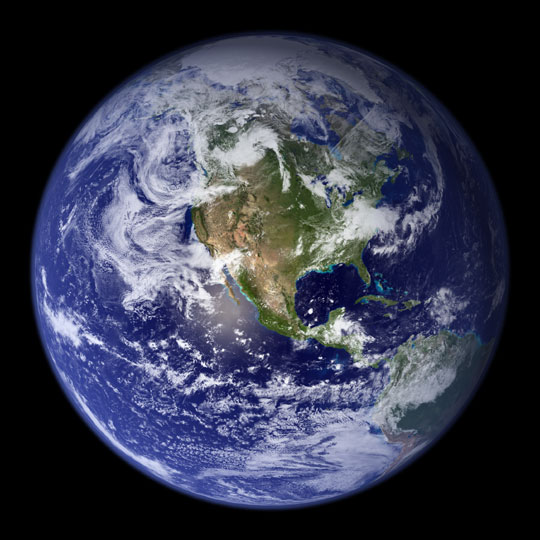

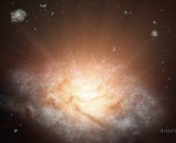
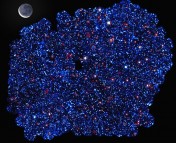
A Direct Collapse of a Supermassive Black Star
The remnant core of a supernova, with a mass between 1.44 and 2 solar masses, will contract down to a neutron star. The internal pressure throughout this neutron star becomes high enough to stop this contraction.
With a higher mass, between 2.2 and 15 solar masses, the remnant will relatively contract down to a black star. It is commonly accepted that time comes to a standstill at the event horizon of a black hole. Calculations show that there is more to this picture when you consider what happened before there was an event horizon. If we go back in time when this remnant of neutron matter was 1.6 times larger than the event horizon, and it is still contracting, the gravitational potential gets extremely close to the value that causes time to freeze, starting at the center. While the outer surface is contracting in, the radius where time freezes cascades out, almost to the surface, creating a black star made of solid neutron matter. The radius at the surface ends up being slightly larger than the radius that defines a black hole, the Schwarzschild radius. The ‘time freeze’ relatively stops the black star from contracting. These stellar black stars were created out of used star matter (neutron matter) which does not fuse and interfere with their creation. Larger black stars are less dense than smaller ones.
Now let’s consider a supermassive black star directly collapsing from a large ball of hydrogen gas. When this ball of gas is large enough, the gravitational potential will reach a value that will cause time to freeze before the density gets high enough to fuse. Supermassive black stars larger than 4 million solar masses would not have a star ignition problem and could be made of pure hydrogen. This allows for a direct collapse of hydrogen into supermassive black stars without the problem of star ignition.
As an example of a larger supermassive black star being created by a direct collapse, if we take a 10 billion solar mass ball of hydrogen gas, and let it contract, the density at the center only gets up to 0.02 kg/m3 when the gravitational potential causes time to begin its freeze. This massive black star is starting its creation way below the density where hydrogen begins to fuse. The remainder of the gas will continue to contract in, and freeze in place at this same density, creating a supermassive black star.
A direct collapse presents an ideal condition for the creation of supermassive black stars and quasars in the early universe when hydrogen was more expansive and abundant. After their creation, the pressure of light radiates out from accretion disks and jets, pushing back gasses into dense clumps, starting the creation of the first stars in the galaxy. In these larger galaxies, supermassive black stars came before stars.
Conventional black holes cannot be created by a direct collapse because the hydrogen gas, on its way to becoming part of the singularity, would contract across densities that heat and fuse, preventing any further contraction toward the singularity. The contraction is stopped by fusion at the density where stars are created.
And now, the rest of the story. You can see this complete episode of black stars at:
https://NeutronStarsAndBlackStars.com
David Clark